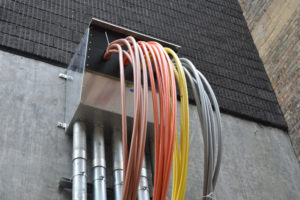Fiber optic construction in cities can be especially challenging. As a native New Yorker, I’m used to seeing construction taking place everywhere. Streets are constantly trenched, repaired, retrenched and re-repaired to manage the inner workings of the city. Verizon or Empire City Subway is always doing something.
My Dad laid a lot of the fiber and copper throughout the five boroughs and I manage the projects to get trucks rolling for the big build outs. Again, fiber optic construction in cities can be tricky. Whether moratorium’s when work is halted, like during the holidays, or changes in codes and permitting there’s a lot to manage. Making matters worse, if you’re worried about stuff like this, you probably have a lot of other stuff going on like moving or purchasing office furniture, equipment, networking gear, personnel, phones, etc.

Breaking ground in Chicago
Last year we were in Chicago for the Data Center World conference at the Art Institute where we presented our value add. Although our sponsorship of happy hour was surely a value add, our true value as displayed is to manage complex migrations for large organizations. Whether building a new office, moving your office, migrating your data center, or moving to more of a hybrid architecture, you’re going to want to work with folks that have done this a few times in the past.
While in Chicago we worked with a few carriers on a fiber optic construction project to build out to our site and extend the fiber into and up one of the larger buildings on LaSalle. Of course, we had diversity coming into the building from diverse carriers with route and pop diversity. Once in the building, working with the union to extend the circuit was a breeze. The union managed everything past the zero manhole making the fiber optic construction a breeze. Chicago, because of its extensive financial markets, has a huge demand for telecom related services to connect to exchanges for trade execution, market data from Bloomberg or Reuters, and basic phones and internet.

Fiber Termination – Chicago – Building Demark
I can’t tell you how many times I’ve heard a business leader say, “It only takes a couple of days at home for Joe’s Cable Co to move my service”. It’s easy to mistake the complexity of full duplex, dedicated bandwidth for the cable internet you have at home. They’re not the same. The internet we provide is what would power a whole neighborhood, so it takes a little longer to engineer paths for data to hit the POP. Even in a LIT building and no circuit extension needed there’s still work to do and some of it is outside of the carriers hands being forced to rely on the landlord, town, or even organizations like ARINs who supplies your IP addresses. Laying the fiber optic cables themselves is one piece of the puzzle, they still need to be engineered and designed to connect to the WAN.
Rural areas present their own set of challenges with the distances between sites a minor problem in comparison to the terrain itself. The right rock will make the wrong blade useless in an instant. Trees, turns, animals, rivers, etc. will also throw a monkey wrench in your plans in a rural area. Reliable power at all of these intersections is also a must. These issues don’t care if you’re using Agile or Waterfall framework because you’re probably not agile enough to get that fiber through that waterfall. We’re certainly looking forward to seeing more companies use solar and line of site to extend networks past their wired capacity and further bridging the urban-rural divide.
We’re in the manholes and up on the poles laying fiber both aerially and terrestrially, trenching up the ground to connect companies to the world. Our partners at AT&T, Comcast Business, Altice, Crown Castle, Zayo, CenturyLink, Spectrum, Frontier, Verizon, British Telecom, and many others come to us to coordinate with customers, landlords, property managers, and others that have roles in the install process.
